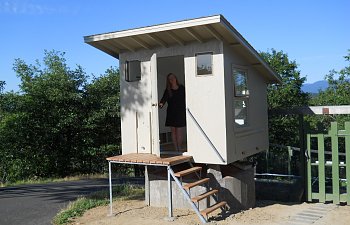The most unusual thing about our coop design is that it is built above a 1,200 gallon cistern which fills off the coop roof and the garden shed roof next to it. Since the plastic tank isn't strong enough to hold the weight of the coop, the first step was to surround the tank with four inches of reinforced concrete for the coop's foundation. The windows in the front are old retail display case tempered glass in aluminum frames and the larger windows on both sides are salvaged from a remodel of my own house. The human door is such an odd size I had to start from scratch rather than cut down a bought door.
Cross-ventilation is excellent in the summer with both side windows open. With the top of the human door right up to the ceiling, hot air spills out easily when it is open during the day. The "deck" in front was necessary for us to get in, but it turns out that the chickens use it every day in the same way we humans use our decks: a hang-out place. At first I thought I would need to add a ramp for them to walk up, but they negotiate the steps with ease.
The name, Myrtle House, comes from Myrtle, the pet chicken who jumped into Arnhem Bridge with the British First Parachute Division on September 17th, 1944. Sadly, she was killed in the combat and buried with full military honors even as her grieving humans were still under fire. It's just a reminder that wherever we go and whatever we do, chickens are right there with us -- if not in person like Myrtle, then as part of our own bodies in the eggs and meat we get from them. Chicken coops are part of our side of the bargain struck with chicken-kind to keep them safe and comfortable, so we always owe them the best we can do in what we provide for them to live in.



Cross-ventilation is excellent in the summer with both side windows open. With the top of the human door right up to the ceiling, hot air spills out easily when it is open during the day. The "deck" in front was necessary for us to get in, but it turns out that the chickens use it every day in the same way we humans use our decks: a hang-out place. At first I thought I would need to add a ramp for them to walk up, but they negotiate the steps with ease.
The name, Myrtle House, comes from Myrtle, the pet chicken who jumped into Arnhem Bridge with the British First Parachute Division on September 17th, 1944. Sadly, she was killed in the combat and buried with full military honors even as her grieving humans were still under fire. It's just a reminder that wherever we go and whatever we do, chickens are right there with us -- if not in person like Myrtle, then as part of our own bodies in the eggs and meat we get from them. Chicken coops are part of our side of the bargain struck with chicken-kind to keep them safe and comfortable, so we always owe them the best we can do in what we provide for them to live in.

